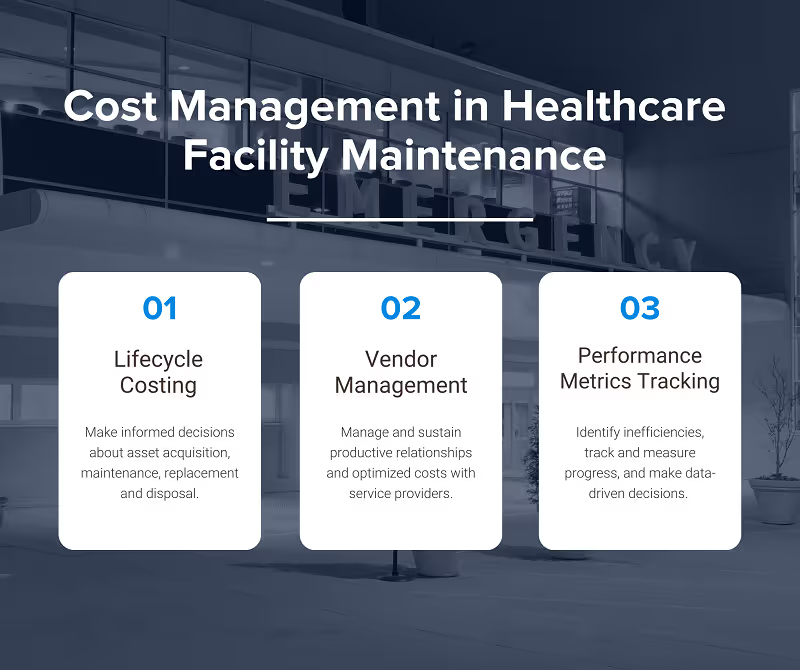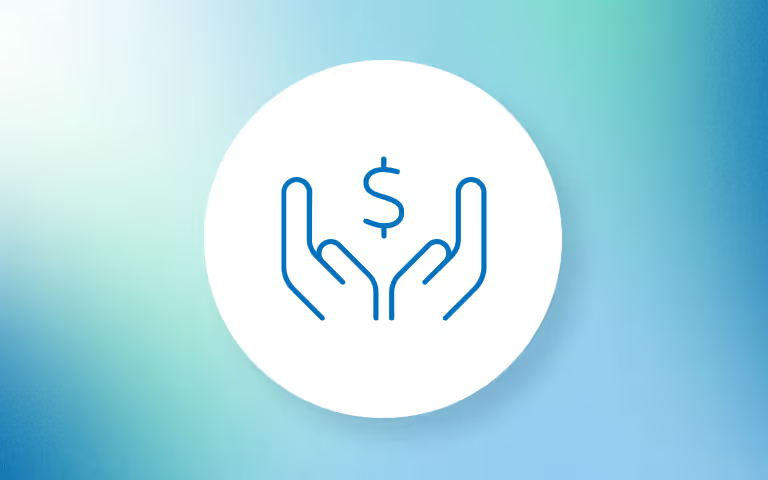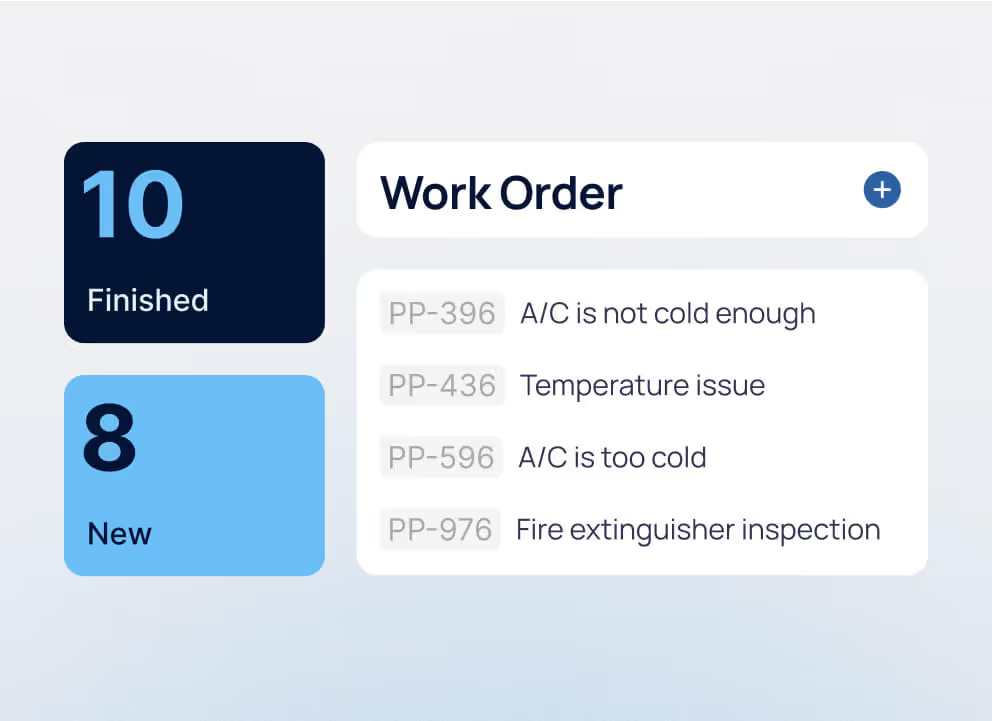Three Strategies to Optimize Maintenance Costs in Healthcare Facilities
Three Strategies to Optimize Maintenance Costs in Healthcare Facilities
In this post
%20(1).avif)
1
2
3
Three Strategies to Optimize Maintenance Costs in Healthcare Facilities
By implementing cost management strategies, healthcare facilities teams will contribute to better patient experiences and improved overall healthcare outcomes.
Efficient cost management is crucial for healthcare facilities to provide high-quality patient care while maintaining financial sustainability. There are many ways to optimize maintenance costs in healthcare facilities, including lifecycle costing, vendor management, and performance metrics tracking. By implementing these strategies with the addition of healthcare maintenance software, healthcare organizations can streamline operations, enhance cost efficiency, and improve overall facility maintenance.

Lifecycle Costing
Lifecycle costing considers the total cost of asset ownership throughout its lifespan. By leveraging a CMMS software for healthcare
assets, teams can gain more visibility of their asset information. This approach provides healthcare facilities with data to make informed decisions about asset acquisition, maintenance, replacement, and disposal.
- Asset Acquisition: In addition to the initial purchase cost, evaluate the ongoing maintenance, repair, and operational expenses. Asset management for healthcare is important for long-term capital planning. Choose assets that provide long-term value and align with facility requirements.
- Preventive Maintenance: Regularly scheduled maintenance helps identify and address issues before they become costly problems. Reduce the risk of unplanned downtime, extends asset lifespan, and minimizes repair costs with preventive maintenance scheduling.
- Replacement and Disposal: Determine the optimal time for asset replacement based on various factors; maintenance costs, technological advancements, and energy efficiency. Generate cost savings through proper disposal methods, like recycling and salvage.
Vendor Management
Effective vendor management ensures healthcare facilities maintain productive relationships with service providers while optimizing costs.
- Competitive Bidding: Obtain multiple quotes from vendors to guarantee competitive pricing. Make informed decisions by comparing services, warranties, and experience.
- Service Level Agreements (SLAs): Establish clear expectations and performance standards in SLAs. Monitor vendor performance regularly and hold them accountable for meeting agreed-upon metrics.
- Consolidated Purchasing: Leverage bulk purchasing and negotiate volume discounts with vendors. Centralize procurement processes to eliminate duplication and streamline operations.
Performance Metrics Tracking
Tracking facility performance metrics aids in identifying areas of inefficiency, measuring progress, and making data-driven decisions.
- Maintenance Costs as a Percentage of Asset Value: Monitor the ratio of maintenance costs to the value of assets. Identify assets with high maintenance costs for potential replacement or reallocation of resources.
- Mean Time Between Failures (MTBF): Measure the average time between asset failures. A higher MTBF indicates improved reliability and reduced maintenance costs.
- Work Order Completion Rate: Track the percentage of work orders completed within the expected timeframe. Identify bottlenecks and inefficiencies in the maintenance process.
Embracing optimized cost management approaches in healthcare facilities will ultimately contribute to better patient experiences and improved overall healthcare outcomes. By implementing these strategies, healthcare organizations can enhance cost efficiency, streamline operations, and ensure optimal facility maintenance.
Schedule a demo to learn how TMA Systems can help you gain better insight and reach your budget goals with our trusted and innovative CMMS software for healthcare.
- Extend asset value by making smarter repair-vs-replace decisions.
- Control spend through better vendor management and purchasing strategies.
- Find hidden savings with data-backed insights into costs and performance.

Download the eBook now
You’re all set!
Your eBook is on its way to your inbox. We hope it brings fresh insights and practical takeaways to help you get more from your maintenance operations.
Explore related resources
.avif)
.svg)
Three Strategies to Optimize Maintenance Costs in Healthcare Facilities
By implementing cost management strategies, healthcare facilities teams will contribute to better patient experiences and improved overall healthcare outcomes.
Efficient cost management is crucial for healthcare facilities to provide high-quality patient care while maintaining financial sustainability. There are many ways to optimize maintenance costs in healthcare facilities, including lifecycle costing, vendor management, and performance metrics tracking. By implementing these strategies with the addition of healthcare maintenance software, healthcare organizations can streamline operations, enhance cost efficiency, and improve overall facility maintenance.

Lifecycle Costing
Lifecycle costing considers the total cost of asset ownership throughout its lifespan. By leveraging a CMMS software for healthcare
assets, teams can gain more visibility of their asset information. This approach provides healthcare facilities with data to make informed decisions about asset acquisition, maintenance, replacement, and disposal.
- Asset Acquisition: In addition to the initial purchase cost, evaluate the ongoing maintenance, repair, and operational expenses. Asset management for healthcare is important for long-term capital planning. Choose assets that provide long-term value and align with facility requirements.
- Preventive Maintenance: Regularly scheduled maintenance helps identify and address issues before they become costly problems. Reduce the risk of unplanned downtime, extends asset lifespan, and minimizes repair costs with preventive maintenance scheduling.
- Replacement and Disposal: Determine the optimal time for asset replacement based on various factors; maintenance costs, technological advancements, and energy efficiency. Generate cost savings through proper disposal methods, like recycling and salvage.
Vendor Management
Effective vendor management ensures healthcare facilities maintain productive relationships with service providers while optimizing costs.
- Competitive Bidding: Obtain multiple quotes from vendors to guarantee competitive pricing. Make informed decisions by comparing services, warranties, and experience.
- Service Level Agreements (SLAs): Establish clear expectations and performance standards in SLAs. Monitor vendor performance regularly and hold them accountable for meeting agreed-upon metrics.
- Consolidated Purchasing: Leverage bulk purchasing and negotiate volume discounts with vendors. Centralize procurement processes to eliminate duplication and streamline operations.
Performance Metrics Tracking
Tracking facility performance metrics aids in identifying areas of inefficiency, measuring progress, and making data-driven decisions.
- Maintenance Costs as a Percentage of Asset Value: Monitor the ratio of maintenance costs to the value of assets. Identify assets with high maintenance costs for potential replacement or reallocation of resources.
- Mean Time Between Failures (MTBF): Measure the average time between asset failures. A higher MTBF indicates improved reliability and reduced maintenance costs.
- Work Order Completion Rate: Track the percentage of work orders completed within the expected timeframe. Identify bottlenecks and inefficiencies in the maintenance process.
Embracing optimized cost management approaches in healthcare facilities will ultimately contribute to better patient experiences and improved overall healthcare outcomes. By implementing these strategies, healthcare organizations can enhance cost efficiency, streamline operations, and ensure optimal facility maintenance.
Schedule a demo to learn how TMA Systems can help you gain better insight and reach your budget goals with our trusted and innovative CMMS software for healthcare.
- Extend asset value by making smarter repair-vs-replace decisions.
- Control spend through better vendor management and purchasing strategies.
- Find hidden savings with data-backed insights into costs and performance.

Register for your free webinar
You’re all set!
Your webinar is on its way to your inbox. We hope it brings fresh insights and practical takeaways to help you get more from your maintenance operations.
Explore related resources
.avif)
.svg)
Three Strategies to Optimize Maintenance Costs in Healthcare Facilities
Three Strategies to Optimize Maintenance Costs in Healthcare Facilities
Three Strategies to Optimize Maintenance Costs in Healthcare Facilities

Efficient cost management is crucial for healthcare facilities to provide high-quality patient care while maintaining financial sustainability. There are many ways to optimize maintenance costs in healthcare facilities, including lifecycle costing, vendor management, and performance metrics tracking. By implementing these strategies with the addition of healthcare maintenance software, healthcare organizations can streamline operations, enhance cost efficiency, and improve overall facility maintenance.

Lifecycle Costing
Lifecycle costing considers the total cost of asset ownership throughout its lifespan. By leveraging a CMMS software for healthcare
assets, teams can gain more visibility of their asset information. This approach provides healthcare facilities with data to make informed decisions about asset acquisition, maintenance, replacement, and disposal.
- Asset Acquisition: In addition to the initial purchase cost, evaluate the ongoing maintenance, repair, and operational expenses. Asset management for healthcare is important for long-term capital planning. Choose assets that provide long-term value and align with facility requirements.
- Preventive Maintenance: Regularly scheduled maintenance helps identify and address issues before they become costly problems. Reduce the risk of unplanned downtime, extends asset lifespan, and minimizes repair costs with preventive maintenance scheduling.
- Replacement and Disposal: Determine the optimal time for asset replacement based on various factors; maintenance costs, technological advancements, and energy efficiency. Generate cost savings through proper disposal methods, like recycling and salvage.
Vendor Management
Effective vendor management ensures healthcare facilities maintain productive relationships with service providers while optimizing costs.
- Competitive Bidding: Obtain multiple quotes from vendors to guarantee competitive pricing. Make informed decisions by comparing services, warranties, and experience.
- Service Level Agreements (SLAs): Establish clear expectations and performance standards in SLAs. Monitor vendor performance regularly and hold them accountable for meeting agreed-upon metrics.
- Consolidated Purchasing: Leverage bulk purchasing and negotiate volume discounts with vendors. Centralize procurement processes to eliminate duplication and streamline operations.
Performance Metrics Tracking
Tracking facility performance metrics aids in identifying areas of inefficiency, measuring progress, and making data-driven decisions.
- Maintenance Costs as a Percentage of Asset Value: Monitor the ratio of maintenance costs to the value of assets. Identify assets with high maintenance costs for potential replacement or reallocation of resources.
- Mean Time Between Failures (MTBF): Measure the average time between asset failures. A higher MTBF indicates improved reliability and reduced maintenance costs.
- Work Order Completion Rate: Track the percentage of work orders completed within the expected timeframe. Identify bottlenecks and inefficiencies in the maintenance process.
Embracing optimized cost management approaches in healthcare facilities will ultimately contribute to better patient experiences and improved overall healthcare outcomes. By implementing these strategies, healthcare organizations can enhance cost efficiency, streamline operations, and ensure optimal facility maintenance.
Schedule a demo to learn how TMA Systems can help you gain better insight and reach your budget goals with our trusted and innovative CMMS software for healthcare.


Related resources
Related resources
You’ve seen what’s possible—connect with us to learn how TMA Systems can support your goals beyond the event.
You’ve read the insights, now see how TMA Systems helps teams put them into practice.
From ideas to impact
You’ve read the insights, now see how TMA Systems helps teams put them into practice.
From screen to solution
You’ve watched what’s possible, now see how TMA Systems works for your organization.
From insight to implementation
You’ve explored the strategies, now see how we can bring them to life across your real facilities.
From insight to implementation
You’ve explored the strategies, now see how we can bring them to life across your real facilities.




.svg)


.avif)



